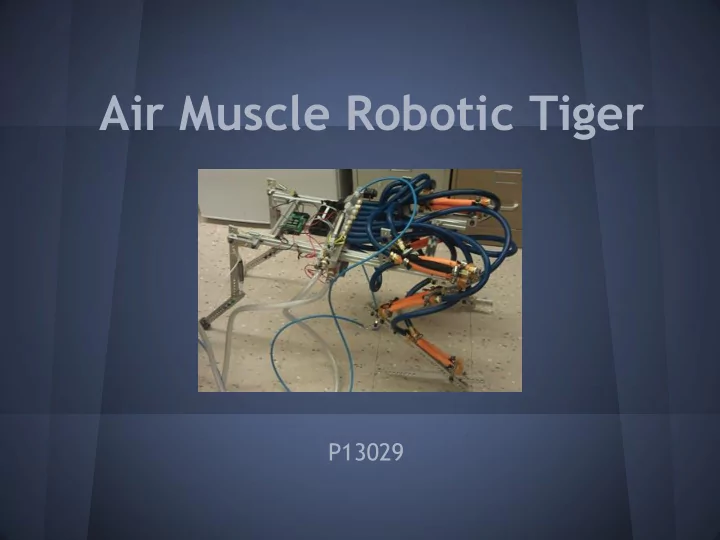

Air Muscle Robotic Tiger P13029
Presentation Agenda • Specs and Customer Needs • Concept Summary • Design Summary • System Testing Results • Successes and Failures • Future Work Suggestions
Project Description • Goal of project was to create a robot using McKibben Air Muscles to mimic the jumping motion of a tiger • The project builds upon past research and MSD projects on air muscles • First RIT air muscle project requiring large muscle forces and quick fill times
Customer Needs Customer Importance (1 = high) Description Need CN1 1 Can jump forward a distance equal to at least the length of its body (only 1 jump required per tank fill) CN2 1 Use air muscles to provide jumping force CN3 1 Lands safely without damage CN4 2 Is ready to jump again after landing, without user adjustment of robot body or legs CN5 2 Self-contained (on board power sources) CN6 2 Portable (small enough for one person to carry) CN7 2 Reasonable battery life; battery charging takes hours CN8 3 Resemble a tiger CN9 3 Controls do not yield a noticeable delay
Engineering Specs (green ideal, yellow marginal, red out of desired range, blue no longer applicable)
Concept Summary
Concept Summary
Final Design
Final Design: Mechanics • 80/20 frame Allowed for adjustment of o anchor points Easy assembly o • Leg design Adjustable anchor points, hard o stops, and pivot points Easy to manufacture o Lightweight o • Springs Dampening springs o
Final Design: Mechanics • Lower friction Nylon washers added to reduce joint friction o Stainless steel dowel pins o • Front legs Fixed leg positions to help stabilize landing o Keep body upright while jumping and landing o • Feet Reduce damage to floor/leg and add friction o • Ramp Adjustable o Assists takeoff during jump o
Final Design: Air Supply • 10 gallon, 200 psi tethered air tanks Reduce weight o Minimal pressure drop o • Manifold Distributes air to upper and lower muscle groups o • Flexible tubing (blue) Unrestricted motion o High pressure o
Final Design: Controls • Arduino controls muscle firing order o Used Labview during testing • Pneumatic actuator on main muscle valve o Fast air release into the muscles • Solenoids o Exhaust to allow leg return after jump • 24V Battery o Powers solenoids, relay board, arduino
Final Design: Muscles • 3/8" brass fittings • 3/4" to 1-3/4" mesh range • 3/8" ID 1/8" THK Very soft silicone rubber tubing
Deviations From Concept • No onboard tank o Became tethered o Top rack removed • Ramp added for legs to push against • More Muscles added o From 1 per leg to 2-3 per leg • Muscle group delay timing o 100ms delay between upper and lower muscles • Manifold/actuator o Ball valve instead of sprinkler
Test Plan 1. Muscle Testing/Development a. Vary tube thickness b. Vary orifice size 2. Theoretical Analysis a. Matlab simulation discontinued i. Time consuming/inaccurate 3. Prototype Build a. Machining of 80/20 frame, legs 4. Prototype Testing a. Tanks were too heavy, parts needed to be removed to achieve jump 5. Arduino Testing a. Arduino program used muscle timing delays found through labview testing
Muscle Testing • Varied muscle orifice size and wall thickness • Optimal: Largest orifice and medium wall thickness
Jump Testing Varied ramp jump angle and muscle grouping delay Largest jump: 100 ms at 17 deg
Successes • Robot jumped farther than it's body length • Repeatability was confirmed • Arduino muscle delay and solenoids were fired as a standalone system • Lands without damage
Failures • Chassis too heavy o Tethered instead of onboard air supply • Exhaust solenoid broke o Hind legs do not return o No spring return • Inconsistent actuator return due to valve stick • Mesh fatigue eventually causing failure Too Heavy Fatigue
Further Work • Muscle exhaust and spring return • Further weight reduction o Lighter frame, fittings, battery • Untether o Lightweight tanks • Elastic muscle connections • Make robot resemble a tiger • Remove need for ramp
Questions?
Recommend
More recommend